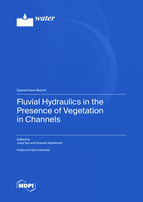Numerical Investigation of Hydrodynamics in a U-Shaped Open Channel Confluence Flow with Partially Emergent Rigid Vegetation
Round 1
Reviewer 1 Report
Generally, the manuscript is well-written. The general discussion is descriptive. The data are not uninteresting and are mostly appropriately set in the context of the surrounding literature. The CFD part of this work is flawless.
“curved open-channel confluence” is definitely a unique, rare case. Dealing with 4000+ miles vegetated channel canals, never seen this case. This might be useful for practitioners.
#47: confluence of the Kaskaskia River and Copper Slough… where is this? Add a location, e.g. in the State of Illinois, USA. Likewise for line 161: Wuhan University, China..
#54: removed the first name: George Constantinescu et al. [7, 8]
Literature review is not critical and simply provides the list of researchers with providing title of their work. The authors need to overhaul this section. We do not need to read the list of the authors of previous work on this topic. Google can tell us this. We need to know what they have found and what are missing. What findings are you going to build upon? What are the critical points that we need to know?
I suggest the authors add a short paragraph about general challenges/unknown of flow through vegetation. I was surprised to not see any of Prof. Nepf’s paper cited here. This is for the benefit of authors to connect themselves to those fundamental studies and get familiarity (more citation) from their group:
https://nepf.mit.edu/publications/
what happens if the confluence is not sharp at the apex of the curve? For instance the connection happens to be in sec 2 or 3 in Fig. 5a. Can the authors shed some lights on this or looking at it as a sensitivity analysis?
Author Response
Please see the attachment.
Author Response File: ![]() Author Response.docx
Author Response.docx
Reviewer 2 Report
In this paper, the hydrodynamics of a U-shape open channel confluence flow with partially rigid emergent vegetation were simulated by the RNG k-ε numerical model coupled with VOF method in OpenFOAM. Based on the hydraulics experiment data and numerical simulation experiment, the flow analysis is carried out from the aspects of flow velocity, separation zone, water level, cross-section secondary flows and bed shear stress, etc. , the influence process of partially rigid emergent vegetation on the hydrodynamic forces of U-shaped open channel is obtained. In general, the manuscript is well written, the structure of the paper is reasonable, and the expression is clear, but only in the experimental design, it is recommended to supplement the basis for scheme design and parameter value setting.
My comments for this manuscript are as follows:
1.The confluence of the main flow and the tributary is located in the middle of the U-shaped open channel, and the confluence was located at a 90° cross section of the curved reach and the confluence angle between the tributary and the main channel was also 90°. In this paper, the hydrodynamic correlation research is carried out under this special condition, and it is suggested that the condition of confluence angle greater than 90 ° and less than 90 ° should be considered. In addition, it is possible to consider the conditions of confluence at different locations in the curved reach. It is helpful to perfect the research content of U-shaped channel confluence.
2.The rigid vegetation is mainly distributed in the 0.25 m wide vegetation area on the concave bank side behind the confluence point. It is suggested that the vegetation area with different width and length should be set up, or that the vegetation area should be set up in the whole bending section, in order to explore the impact of the vegetation area scale on the hydrodynamics of the confluence in the region.
3.It is suggested that in the eight cases set in this article, the main channel inflow discharge ?? is also set to two values of different sizes like the tributary discharge ??.
4.The evaluation basis that the simulation results coincide with the experimental data should be established.
5.Clarify the water permeability of rigid plants and the calculation of rigid plant resistance
6.Check the flow direction of the outlet section in Figure 8 (a)
7. The theoretical innovation of this paper and the in-depth analysis of the basic laws of fluid structure interaction on U-shaped channel flow are still insufficien.
Author Response
Please see the attachment.
Author Response File: ![]() Author Response.docx
Author Response.docx




